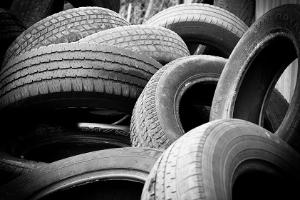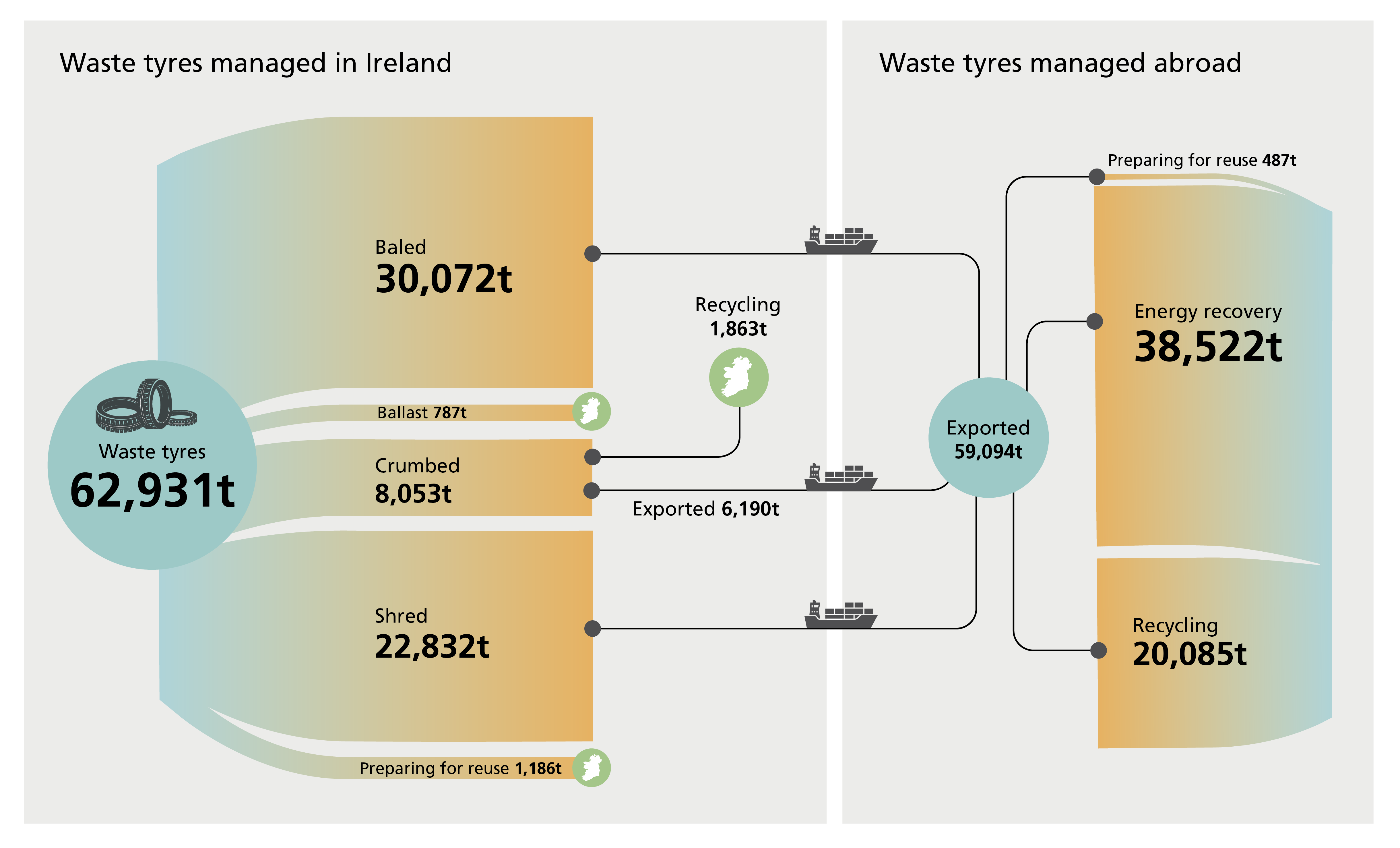Waste Tyre Statistics for Ireland
EPA waste data release, June 2024. Latest reference year 2022.
Waste tyres pose a threat to the atmosphere, to land, soil, water, plants and animals if they are not managed properly. Where they are dumped in our environment, they have a significant negative visual impact on our landscape. Tyres become waste when worn-out tyres on a vehicle are replaced; and, unless reused, they become waste when the vehicle they are on is transferred to an authorised treatment facility. Our section on end-of-life vehicles provides more information on end-of-life vehicles arising in Ireland, and reuse, recycling and other recovery of this waste.

Key trends
- A total of 62,931 tonnes of waste tyres were collected and treated in Ireland in 2022. This represents an increase of 43% on the 40,393 tonnes collected in the last reporting year 2020 and 30% from 2019. This trend reflects an increase in tyres placed on the market from 2020[1] and increased vehicle sales over this period (19% increase in 2021 and 15.8% increase in 2022)[2]. Rising traffic volumes following the Covid-19 pandemic also resulted in tyres being replaced more frequently than during 2020[3].
- In previous years, recycling in Ireland or abroad was the most common treatment route for tyres collected in Ireland representing 68% of final treatment. However, in 2022, energy recovery was the most common treatment route representing 61% of final treatment and recycling decreasing to 35% (Figure 1 & 2).
- The share of waste tyres used for energy recovery increased significantly from 10,940t in 2020 to 38,522t in 2022. Less tyres were recycled in Ireland or abroad due to an increased demand for tyres from energy recovery operators (in particular cement kilns) as an alternative to coal as tyres have a similar calorific value.
- There was a decrease in the tonnage of waste tyres crumbed for recycling in Ireland, down from 5,825 tonnes 2020 to 1,863 tonnes in 2022 as a result of rising energy costs and more economically viable options abroad.
- The majority (93 per cent) of waste tyres were exported for final treatment abroad in 2022, mainly to Asian countries. This is an increase from 2020, when 81% of tyres were exported. This indicates an increasing reliance on export for treatment for waste tyres.
- Of the 59,094t of waste tyres exported in 2022, the majority were sent for energy recovery at 65 per cent (38,522t), 34 per cent went for recycling (20,085t) and approximately 0.8 per cent were prepared for reuse (487t).
Figure 1 shows how waste tyres moved through the waste treatment network in Ireland in 2022. Most waste tyres are collected by authorised waste collectors and brought to a waste facility; and, unless they are used as ballast or prepared for reuse, they are either baled or pre-treated before the final treatment step.
The most common treatment route in 2022 was baling of waste tyres at Irish waste facilities followed by export and final treatment abroad. This accounted for 48 per cent of the waste tyres managed in 2022. The second most common treatment route was shredding of waste tyres in Ireland followed by export. This accounted for 36 per cent of waste tyres managed in 2022. It is reported that this is currently the most economically viable strategy for waste tyre treatment operators.

Figure 1. Waste Tyre management in Ireland 2022
-
Waste tyre final treatment activity 2022
Waste tyre final treatment activity 2022 Quantity (tonnes) Percentage of managed Prepared for reuse 1,673 2.7% Recycled 21,949 34.9% Ballast 787 1.3% Used as a fuel 38,522 61.2% TOTAL 62,931 100.0%
Producer Compliance Scheme
To ensure that waste tyres are handled in an environmentally sound manner, a producer compliance scheme for tyres and waste tyres, operated by Circol ELT (previously Repak ELT), was introduced in October 2017, underpinned by the Tyres and Waste Tyres Regulations 2017. 2018 is the first full calendar year that Circol ELT was in operation. The scheme currently only includes car and motorcycle tyres and does not account for truck, agricultural or construction tyres (note: the EPA data presented encompasses data on all types of waste tyres managed in 2022). The Waste Action Plan for a Circular Economy includes a commitment that the tyres producer compliance scheme will be extended to all categories of tyres provided for by the Tyres Regulations (passenger car, van, 4x4, truck, bus, agricultural and motorcycle tyres).
Reporting Notes
The EPA data on waste tyres draw on multiple sources including EPA surveys, data from the National Waste Collection Permit Office, data on exports from the National Transfrontier Shipments Office, and information from the tyres producer compliance scheme Circol ELT.
There are no statutory recycling or recovery targets set down in the Tyres Regulations[1]. However, Circol ELT’s Ministerial approval obligates the compliance scheme to meet minimum targets for the type of tyres it covers. By the end of 2019, and each subsequent year, it must achieve:
- A recovery rate of 70% of all tyres collected, and
- A recycling rate of 30% of all tyres collected.
References:
[1] https://circolelt.ie/media/dxkp5g0e/circolelt_2022_annualreport_web_small.pdf
[2] https://www.simi.ie/en/motorstats/national-vehicle-statistics
[4] S.I. No. 400/2017 - Waste Management (Tyres and Waste Tyres) Regulations 2017.
To see data from previous years see: Waste Tyres Data Archive | Environmental Protection Agency (epa.ie)